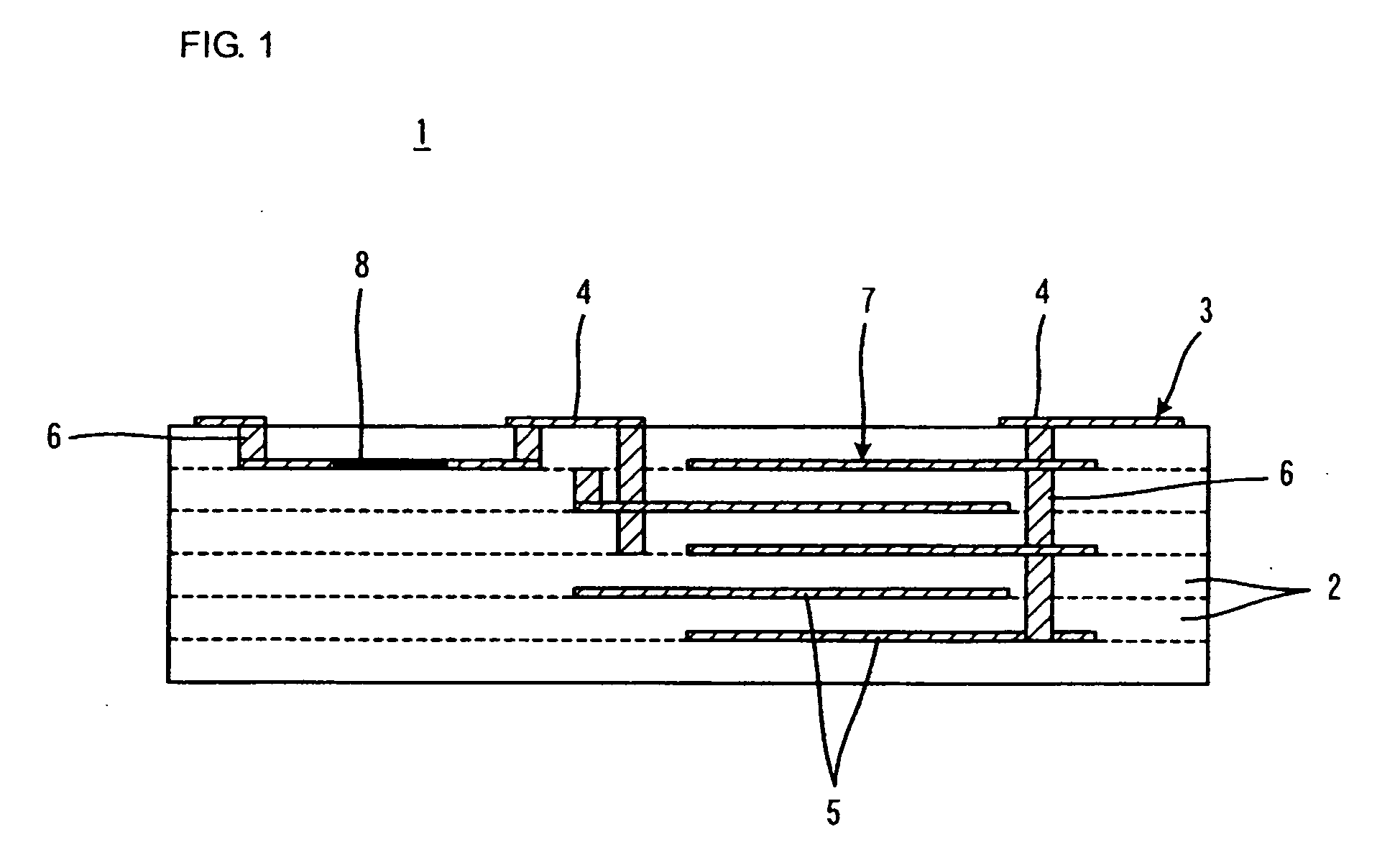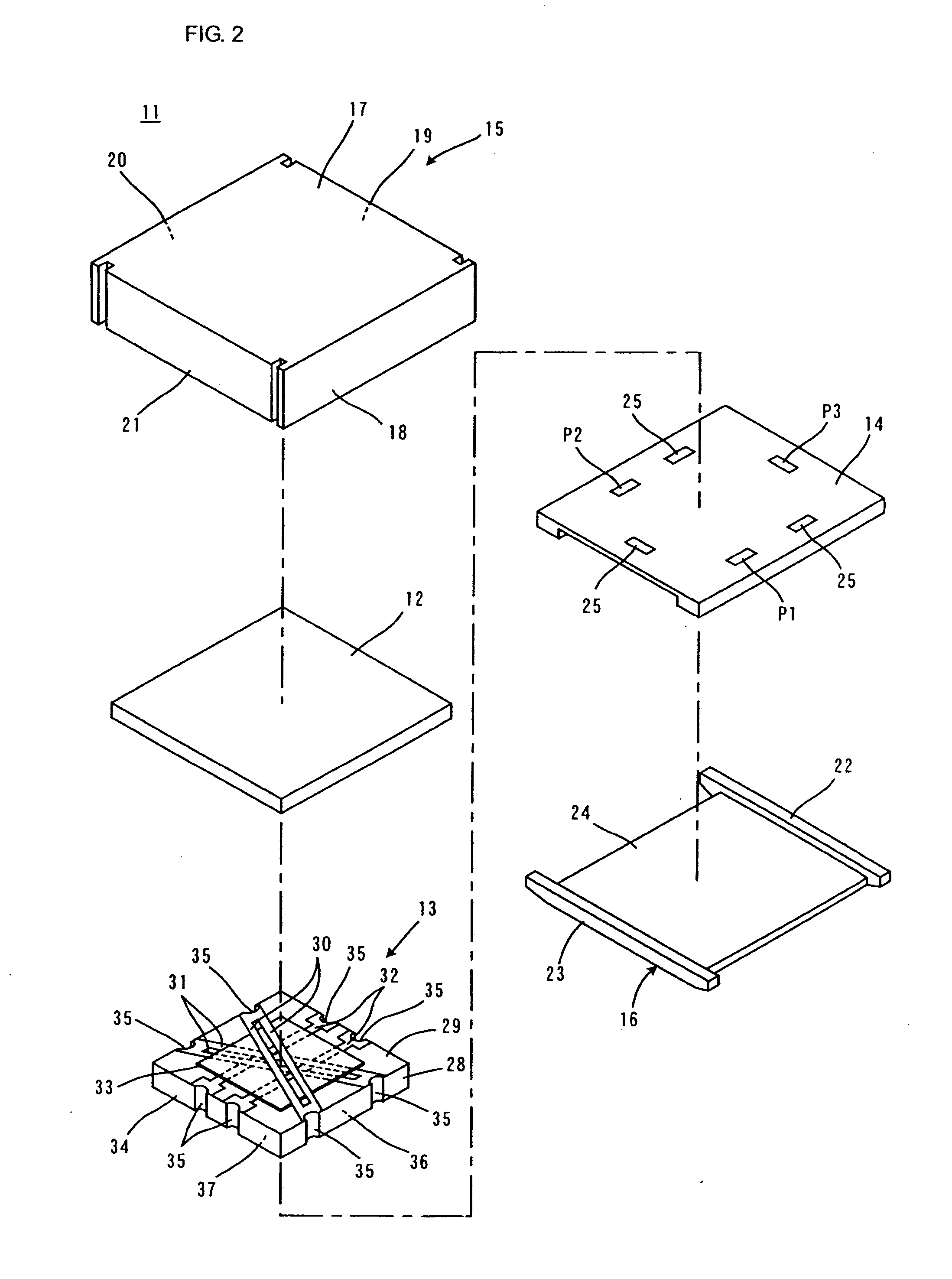Ceramic material composition, ceramic substrate, and nonreciprocal circuit device
- Summary
- Abstract
- Description
- Claims
- Application Information
AI Technical Summary
Benefits of technology
Problems solved by technology
Method used
Image
Examples
experimental example 1
[0083] 1. Production of Ceramic Composition
[0084] To produce a BaO—TiO2—ReO3 / 2 ceramic composition, powders of BaCO3, TiO2, Nd2O3, Pr2O3 and Sm2O3 were weighed so as to achieve contents of BaCO3, TiO2, ReO3 / 2 and the like shown in Table 1, and then the weighed powders were mixed. The resulting material powder mixture was calcined at 1,150° C. for 1 hour. Then, the resulting calcine was pulverized.
[0085] In this way, ceramic compositions S1 to S10 shown in Table 1 were obtained.
TABLE 1Type ofceramicBaOTiO2ReO3 / 2S11358Nd: 10, Sm: 19S22555Nd: 20S3575Nd: 20S4265Nd: 33S51050Nd: 40S61862Nd: 20S7865Nd: 27S8852.5Nd: 39.5S91358Sm: 29 S101358Pr: 6, Sm: 23
(unit: mol %)
[0086] 2. Production of Glass Composition
[0087] To produce a borosilicate glass composition, powders of CaO, MgO, SrO, BaO, Al2O3, B2O3, SiO2, Li2O, Na2O, K2O and PbO were weighed so as to achieve contents shown in Table 2, and then the weighed powders were sufficiently mixed. The resulting material powder mixture melted at...
experimental example 2
[0115] In Experimental Example 2, a ceramic material composition was produced with ceramic composition S1 shown in Table 1 and glass composition G1 shown in Table 2, as shown in Table 5, and then a sintered body of the ceramic material composition was produced in the same way as in Experimental Example 1, except that the contents of the ceramic composition, alumina, and the glass composition were changed.
TABLE 5CeramicGlasscompositionCeO2compositionAmountAluminaparts byAmountSampleType[wt %][wt %]weightType[wt %]33S15.040.00.3G155.034S110.040.00.3G150.035S145.010.00.3G145.036S155.000.3G145.037S145.05.00.3G150.038S142.010.00.3G148.039S112.040.00.3G148.040S110.050.00.3G140.041S145.025.00.3G130.042S140.020.00.3G140.043S123.012.00.3G165.044S120.010.00.3G170.0
[0116] Next, each sample shown in Table 5 was evaluated for dielectric constant, Q-value, the temperature coefficient of capacitance, and reliability in a PCT in the same way as in Experimental Example 1. Furthermore, in Experimen...
experimental example 3
[0124] In Experimental Example 3, as shown in Table 7, a ceramic material composition was produced with ceramic composition S1 shown in Table 1 and glass composition G1 shown in Table 2, and then a sintered body of the ceramic material composition was produced in the same way as in Experimental Example 1, except that the contents of the ceramic composition S1 and CeO2 were changed and, in specific samples, CaTiO3 was added.
TABLE 7CeramicGlasscompositionCeO2compositionAmountAluminaparts byCaTiO3AmountSampleType[wt %][wt %]weight[wt %]Type[wt %]45S134.018.000G148.046S134.018.03.00G148.047S134.018.05.00G148.048S129.018.00.35.0G148.049S114.018.00.320.0G148.050S14.018.00.330.0G148.0
[0125] Next, each sample shown in Table 7 was evaluated for dielectric constant, Q-value, temperature coefficient of capacitance, and reliability in a PCT in the same way as in Experimental Example 1. Table 8 shows the results.
TABLE 8TemperatureDielectriccoefficientconstantQf(TCC)ReliabilitySample(ε)[GHz][...
PUM
| Property | Measurement | Unit |
|---|---|---|
| Time | aaaaa | aaaaa |
| Percent by mass | aaaaa | aaaaa |
| Percent by mass | aaaaa | aaaaa |
Abstract
Description
Claims
Application Information
 Login to View More
Login to View More - R&D
- Intellectual Property
- Life Sciences
- Materials
- Tech Scout
- Unparalleled Data Quality
- Higher Quality Content
- 60% Fewer Hallucinations
Browse by: Latest US Patents, China's latest patents, Technical Efficacy Thesaurus, Application Domain, Technology Topic, Popular Technical Reports.
© 2025 PatSnap. All rights reserved.Legal|Privacy policy|Modern Slavery Act Transparency Statement|Sitemap|About US| Contact US: help@patsnap.com



